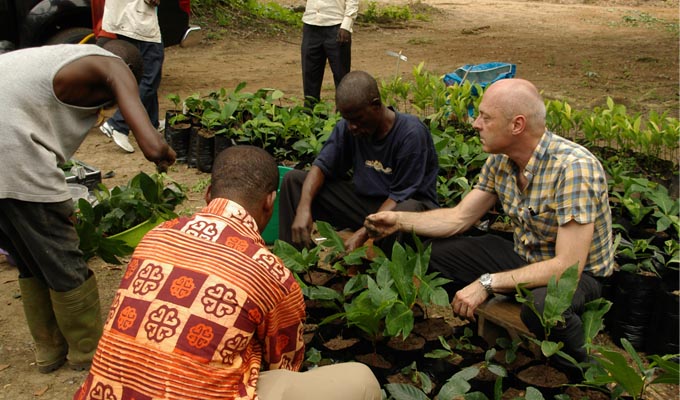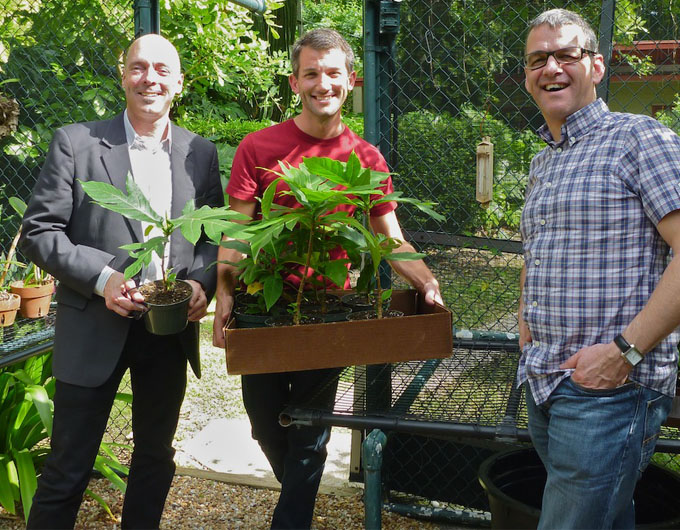Josh Schneider is a horticulturist and friend of BatesMeron working to rid the world of hunger with the help of an unconventional plant, breadfruit. Part of the management team for Global Breadfruit, a company that works to produce and spread breadfruit around the globe, Josh works with plant breeders to develop new and improved crops as well as introduce those plants to market.
I interviewed Josh as a part of our 6 Questions feature: a series of one-on-one interviews with people we work with who’ve made us proud. In addition to speaking with our clients to see how they’re rocking their brands, I also like to talk with them to see how their brand, their vision and their talents are impacting the world.
In this case, I spoke with Josh to learn why we should care about breadfruit and how it will kick global hunger to the curb.

1. What makes breadfruit a worthy opponent in the battle to conquer world hunger?
Producing prolifically, a single breadfruit tree can feed a family of four for more than 50 years and be consumed at all stages of maturity. Breadfruit is the only natural food source that has the ability to end hunger and hunger-related maladies in the tropics, in addition to possessing the capacity to end infant blindness in Africa in a single generation. The tree is relatively easy to grow and its crop highly nutritious—a considerably healthier alternative to potatoes.
It’s like a sourdough loaf, and it looks like bread, it smells like bread and it tastes like bread.

2. Breadfruit has been around for centuries. Why hasn’t this plant and its hunger-fighting abilities gone commercial?
Breadfruit has been cultivated by man for thousands of years, but gained notoriety in the 18th century during the infamous Mutiny on the Bounty, when Captain Bligh, who was bringing several thousand breadfruit trees from Tahiti to the West Indies, was mutinied by his crew and all the plants thrown overboard.
Until a method of micropropagation was developed by Global Breadfruit, the possibility of commercializing breadfruit on a large-scale simply didn’t exist. Over time, many of the best varieties of breadfruit underwent a naturally occurring mutation, causing them to become sterile and therefore seedless. The seeded varieties do not produce seedlings identical to their parents, making the ability to reproduce the same superior variety from seed propagation impossible. This and other methods of propagation result in an unreliable tree that takes upwards of 10 years to bear fruit, while micropragated varieties result in uniform, vigorous plantlets reliably producing superior fruit in 2-3 years.

3. What are you, Global Breadfruit and other organizations doing to spread the positive impact of this plant?
Realizing the potential of this superfood, Global Breadfruit joined forces with the National Tropical Botanical Garden’s Breadfruit Institute to gain access to their optimal commercial varieties and discovered a method of micropropagation that allows for production of uniform, vigorous plantlets that bear fruit in 2–3 years after planting. This has allowed us to ship life-saving breadfruit trees to 23 underprivileged nations across the globe, including Ghana, Haiti, Jamaica, Myanmar and Nigeria.

4. Can anyone purchase and grow breadfruit to help the effort? If not, what can they do?
Unfortunately, breadfruit only thrives in specific climates (mainly wet and tropical), so trying to grow a breadfruit crop in an unsuitable area wouldn’t be very successful. But don’t feel discouraged! If you don’t live in an area suitable for the cultivation of breadfruit, but want to help those who could benefit from its advantageousness, you can visit TreesThatFeed.org and make a donation to the Trees That Feed Foundation, which has sent tens of thousands of breadfruit trees to impoverished communities and countries around the world.
Infant blindness in Africa could be eradicated in a single generation through breadfruit.
5. When a breadfruit plant has been successfully introduced to an area, what are the reactions and immediate changes seen by people, government and environment?
The implications of planting breadfruit are extremely positive. The trees are huge carbon sinks helping to significantly reduce atmospheric CO2, creating healthier global environments. Foreign governments, who are eager to avoid uprisings, appreciate that breadfruit trees provide their people with food and economic opportunities, facilitating political stability. The people, of course, are happy to have access to a substantial and palatable food source that also provides forms of income.
In Haiti for example, more than 1,000 school children who would otherwise go hungry are being fed two nutritious meals a day of breadfruit porridge. Gluten-free breadfruit flour is now used as an alternative to expensive, imported wheat flour and with demand for breadfruit flour increasing in the Europe and the US, Haiti is helping develop the global export market.

6. Where do you see breadfruit growth across the globe in the next 5 years?
In the next five years, we’d like breadfruit and its valuable byproducts to become household names and staples in every American kitchen. If that can be accomplished, not only will Americans be eating healthier, but it means thousands of breadfruit trees will be flourishing in—and being sourced from—tropical regions across the globe, providing underprivileged nations with enhanced food security and increased methods of generating income for local communities.

A single breadfruit tree can feed a family of 4 for over 50 years.
_____
Global Breadfruit recently launched a new website that BatesMeron is very proud to have been a part of from beginning to end. The website, globalbreadfruit.com, provides an in-depth look at how breadfruit is grown, where it’s grown and why it’s changing the world.
Visit their new site and discover more about this heroic plant! (Plus you’ll get to see our BMSD web skills in action. Win-win.)











